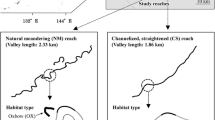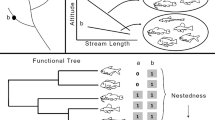Abstract
A dendritic or web-like network is a unique property of inland freshwater systems. The dispersal and movement of freshwater fish are restricted to a network of such waterways. Therefore, during dispersal or movement, fish have to select their way at each junction (i.e. the confluence of two channels) in the network, and their channel selection (route selection) would be reflected in the spatial variations in fish assemblage composition. In this study, we surveyed the channel selection of three fish species during their movement in a braided river. We also analysed correlative patterns among local abundances of fish assemblage members and local habitat variables in study sites established in the channel network, to examine whether fish assemblage composition reflected their channel selection. The channel-selection survey showed that the channels selected by two species, fat minnow and spined loach, were characterised by lower flow volume. These two species tended to avoid stronger currents at the confluence. The analysis of correlative patterns showed that no species were affected by local habitat variables, while the clearest pattern was strong positive correlations between the densities of fat minnow and spined loach, which were found to have similar channel preferences. These results suggest that the fish assemblage composition of local habitats in our braided river reflected channel selection by fish during their movement. Route selection by fish during dispersal or movement can be a notable factor determining the assemblage composition of freshwater fish, especially in habitats where regional processes, rather than local processes, have overriding effects.





Similar content being viewed by others
Data availability
The data used can be obtained from the corresponding author upon reasonable request.
References
Altermatt F (2013) Diversity in riverine metacommunities: a network perspective. Aquat Ecol 47:365–377. https://doi.org/10.1007/s10452-013-9450-3
Arscott DB, Tockner K, Ward JV (2005) Lateral organization of aquatic invertebrates along the corridor of a braided floodplain river. J N Am Benthol Soc 24:934–954. https://doi.org/10.1899/05-037.1
Bain MB, Finn JT, Booke HE (1985) Quantifying stream substrate for habitat analysis studies. N Am J Fish Manag 5:499–500. https://doi.org/10.1577/1548-8659(1985)5%3c499:QSSFHA%3e2.0.CO;2
Benda LE, Poff NL, Miller D, Dunne T, Reeves GH, Pess G, Pollock M (2004) The network dynamics hypothesis: how channel networks structure riverine habitats. Bioscience 54:413–427. https://doi.org/10.1641/0006-3568(2004)054[0413:TNDHHC]2.0.CO;2
Boddy NC, Booker DJ, McIntosh AR (2019) Confluence configuration of river networks controls spatial patterns in fish communities. Landscape Ecol 34:187–201. https://doi.org/10.1007/s10980-018-0763-4
Bouvier LD, Cottenie K, Doka SE (2009) Aquatic connectivity and fish metacommunities in wetlands of the lower Great Lakes. Can J Fish Aquat Sci 66:933–948. https://doi.org/10.1139/F09-050
Caissie D (2006) The thermal regime of rivers: a review. Freshw Biol 51:1389–1406. https://doi.org/10.1111/j.1365-2427.2006.01597.x
Capone TA, Kushlan JA (1991) Fish community structure in dry-season stream pools. Ecology 72:983–992. https://doi.org/10.2307/1940598
Czeglédi I, Sály P, Takács P, Dolezsai A, Nagy SA, Erős T (2016) The scales of variability of stream fish assemblages at tributary confluences. Aquat Sci 78:641–654. https://doi.org/10.1007/s00027-015-0454-z
Ebersole JL, Liss WJ, Frissell CA (2001) Relationship between stream temperature, thermal refugia and rainbow trout Oncorhynchus mykiss abundance in arid-land streams in the northwestern United States. Ecol Freshw Fish 10:1–10. https://doi.org/10.1034/j.1600-0633.2001.100101.x
Fujita T (2015) Takahaya (upstream fat minnow). In: Hosoya K, Uchiyama R, Fujita T, Takeuchi H, Kawase S (eds) Nihon-no-tansui-gyo (freshwater fishes in Japan). Yamatokeikoku-sha, Tokyo, pp 114–115 (in Japanese)
Gore JA (1996) Discharge measurements and streamflow analysis. In: Hauer FR, Lamberti GA (eds) Methods in stream ecology. Academic Press, San Diego, pp 53–74
Grant EHC, Lowe WH, Fagan WF (2007) Living in the branches: population dynamics and ecological processes in dendritic networks. Ecol Lett 10:165–175. https://doi.org/10.1111/j.1461-0248.2006.01007.x
Gray D, Harding JS (2009) Braided river benthic diversity at multiple spatial scales: a hierarchical analysis of β diversity in complex floodplain systems. J N Am Benthol Soc 28:537–551. https://doi.org/10.1899/08-136.1
Hosoya K (2015) Oikawa (pale chub). In: Hosoya K, Uchiyama R, Fujita T, Takeuchi H, Kawase S (eds) Nihon-no-tansui-gyo (freshwater fishes in Japan). Yamatokeikoku-sha, Tokyo, pp 88–89 (in Japanese)
Inoue M, Sakamoto S, Kikuchi S (2013) Terrestrial prey inputs to streams bordered by deciduous broadleaved forests, conifer plantations and clear-cut sites in southwestern Japan: effects on the abundance of red-spotted masu salmon. Ecol Freshw Fish 22:335–347. https://doi.org/10.1111/eff.12029
Ishiyama N, Sueyoshi M, Watanabe N, Nakamura F (2016) Biodiversity and rarity distributions of native freshwater fish in an agricultural landscape: the importance of β diversity between and within water-body types. Aquat Conserv 26:416–428. https://doi.org/10.1002/aqc.2583
Jacobson B, Peres-Neto PR (2010) Quantifying and disentangling dispersal in metacommunities: how close have we come? How far is there to go? Landscape Ecol 25:495–507. https://doi.org/10.1007/s10980-009-9442-9
Koizumi I, Kanazawa Y, Yamazaki C, Tanaka Y, Takaya K (2017) Extreme winter aggregation of invasive rainbow trout in small tributaries: implications for effective control. Ichthyol Res 64:197–203. https://doi.org/10.1007/s10228-016-0558-z
Lasne E, Lek S, Laffaille P (2007) Patterns in fish assemblages in the Loira floodplain: the role of hydrological connectivity and implications for conservation. Biol Conserv 139:258–268. https://doi.org/10.1016/j.biocon.2007.07.002
Lyon J, Stuart I, Ramsey D, O’Mahony J (2010) The effect of water level on lateral movements of fish between river and off-channel habitats and implications for management. Mar Freshw Res 61:271–278. https://doi.org/10.1071/MF08246
Magnuson JJ, Tonn WM, Banerjee A, Toivonen J, Sanchez O, Rask M (1998) Isolation versus extinction in the assembly of fishes in small northern lakes. Ecology 79:2941–2956. https://doi.org/10.1890/0012-9658(1998)079[2941:IVEITA]2.0.CO;2
Malard F, Uehlinger U, Zah R, Tockner K (2006) Flood-pulse and riverscape dynamics in a braided glacial river. Ecology 87:704–716. https://doi.org/10.1890/04-0889
Marshall JC, Menke N, Cook DA, Lobegeiger J, Balcombe S, Huey J, Arthington AH (2016) Go with flow: the movement behaviour of fish from isolated waterhole refugia during connecting flow events in an intermittent dryland river. Freshw Biol 61:1242–1258. https://doi.org/10.1111/fwb.12707
Mori T, Kato Y, Takagi T, Onoda Y, Kayaba Y (2018) Turbid water induces refuge behaviour of a commercially important ayu: a field experiment for interstream movement using multiple artificial streams. Ecol Freshw Fish 27:1015–1022. https://doi.org/10.1111/eff.12411
Moss JL (1985) Summer selection of thermal refuges by striped bass in Alabama reservoirs and tail waters. Trans Am Fisher Soc 114:77–83. https://doi.org/10.1577/1548-8659(1985)114%3c77:SSOTRB%3e2.0.CO;2
Nakajima J, Uchiyama R (2017) Nihon-no-dojyou (loaches of Japan: natural history and culture). Yamatokeikoku-sha, Tokyo (in Japanese)
Rahel FJ (1984) Factors structuring fish assemblages along a bog lake successional gradient. Ecology 65:1276–1289. https://doi.org/10.2307/1938333
Rice SP, Greenwood MT, Joyce CB (2001) Tributaries, sediment sources, and the longitudinal organisation of macroinvertebrate fauna along river systems. Can J Fish Aquat Sci 58:824–840. https://doi.org/10.1139/f01-022
Rodríguez MA, Lewis WM Jr (1994) Regulation and stability in fish assemblages of neotropical floodplain lakes. Oecologia 99:166–180. https://doi.org/10.1007/BF00317098
Rodríguez MA, Lewis WM Jr (1997) Structure of fish assemblages along environmental gradients in floodplain lakes of the Orinoco River. Ecol Monogr 67:109–128. https://doi.org/10.1890/0012-9615(1997)067[0109:SOFAAE]2.0.CO;2
Stoffels RJ, Clarke KR, Linklater D (2015) Temporal dynamics of a local fish community are strongly affected by immigration from the surrounding metacommunity. Ecol Evol 5:200–212. https://doi.org/10.1002/ece3.1369
Sullivan SMP, Watzin MC (2009) Stream-floodplain connectivity and fish assemblage diversity in the Champlain Valley, Vermont, U.S.A. J Fish Biol 74:1394–1418. https://doi.org/10.1111/j.1095-8649.2009.02205.x
Taylor CM (1997) Fish species richness and incidence patterns in isolated and connected stream pools: effects of pool volume and spatial position. Oecologia 110:560–566. https://doi.org/10.1007/s004420050196
Terui A, Ishiyama N, Urabe H, Ono S, Finlay JC, Nakamura F (2018) Metapopulation stability in branching river networks. P Natl Acad Sci USA 115:5963–5968. https://doi.org/10.1073/pnas.1800060115
Uchida Y, Inoue M (2010) Fish species richness in spring-fed ponds: effects of habitat size versus isolation in temporally variable environments. Freshw Biol 55:983–994. https://doi.org/10.1111/j.1365-2427.2009.02335.x
Van der Nat D, Tockner K, Edwards PJ, Ward JV, Gurnell AM (2003) Habitat change in braided flood plains (Tagliamento, NE Italy). Freshw Biol 48:1–14. https://doi.org/10.1046/j.1365-2427.2003.01126.x
Acknowledgements
We thank the many people who gave advice and/or field assistance: H. Doi, K. Hamamoto, H. Hata, Y. Imada, S. Mimachi, T. Nakajima, K. Omori, M. Onishi, S. Okubo, T. Shinohara, A. Sunohara, G. Takemon, Y. Uemura, and K. Yamamoto. We also thank two anonymous reviewers and a handling editor for their helpful comments. The survey in this study was conducted with the permission of the Ehime Prefectural Government and complied with the current laws in Japan. This research was partly supported by a grant from the Foundation of River and Watershed Environment Management, and by the Environmental Research and Technology Development Fund (S9) of the Ministry of Environment, Japan.
Author information
Authors and Affiliations
Corresponding author
Additional information
Handling Editor: Akira Terui.
Publisher's Note
Springer Nature remains neutral with regard to jurisdictional claims in published maps and institutional affiliations.
Supplementary Information
Below is the link to the electronic supplementary material.
Rights and permissions
About this article
Cite this article
Togaki, D., Inoue, M., Shiota, Y. et al. Route selection by fish during post-spate movement in a braided river: a potential effect on local assemblages. Limnology 23, 127–136 (2022). https://doi.org/10.1007/s10201-021-00675-x
Received:
Accepted:
Published:
Issue Date:
DOI: https://doi.org/10.1007/s10201-021-00675-x




